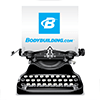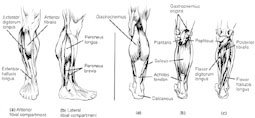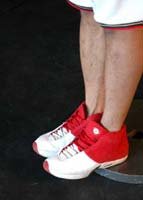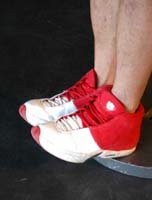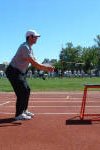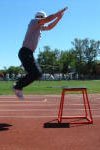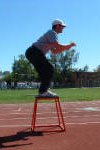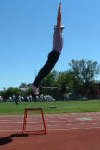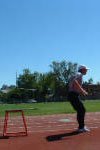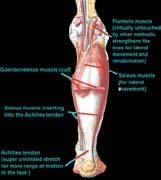You step back to look at the view in the mirror only to notice that you are still lacking lower leg development. How can that be? You have trained calves a million and one ways, you have eaten properly, received adequate rest and still fail to see any distinct results.
Do you suffer from small calf syndrome? Are you tired of putting in 100% effort and receiving only 10% results? Does any of this sound familiar?
Have you ever seen someone who doesn't workout at all or exercises very little, yet they possess beautiful and balanced calves? Just as with any other muscle, calves are genetic.
The length of a muscle and the tendon's insertion point will determine how great your calves will be. Those with short calf muscles and a long tendon insertion will have a much more difficult time building them to greatness, as this makes them smaller and higher.
Building calves can be frustrating and it has to be the most difficult muscle in the body to deliver desired results. Even if you are not genetically gifted in the calf department, there are some tactics that you can employ to maximize your lower leg development.

Calf Structure

Before you can maximize muscle gains in the calves, it is important to understand how they work and what is involved. Calf training requires a different type of intensity, not just more sets, more repetitions, more rest, etc.
You have to understand what is involved to capitalize on gains. Train hard, yet smart. Use your calf muscles as well as your mind. You must focus and visualize.
The calves are composed of two major muscles, the gastrocnemius and the soleus. These two muscles add size, width, and symmetry to the lower portion of the leg. In addition, there is a smaller muscle that comes into play, the tibialis anterior.
Even though it is small and may seem insignificant, it is an important muscle to develop for strength, size, power, endurance, and shape.
 The Gastrocnemius
The Gastrocnemius
-
The gastrocnemius is the larger of the two major calf muscles and it gives shape to the rear lower leg. It is located at the top back of the lower leg and it extends from the knee joint to the ankle joint.
It is composed of two heads (medial and lateral) that lie next to each other. The gastrocnemius can be easily seen when it is well developed and accompanied with low body fat. This muscle portrays that well-known diamond shape or the appearance of an upside down heart.
Best Targeted
-
The gastrocnemius is best targeted with straight legged-heel raises, such as
donkey calf raises and
standing calf raises. Some people put a slight bend in their legs to relive some pressure, but this will only target the soleus more, putting less emphasis on the gastrocnemius.
If you are going to train the gastrocnemius, lock your knees to target it solely. Don't bring other muscles into play.
Donkey raises are superior to standing calf raises due to the position it puts you in. The gastrocnemius ties in with the hamstrings at the back of the leg. When you are in the bent over position, the hamstrings and gastrocnemius are stretched out, giving the donkey calf raise an advantage over standing calf raises, due to the intensity and localization.
The gastrocnemius muscle responds well to heavy poundage, using more sets and fewer repetitions, due to the great number of fast-twitch (white) muscle fibers.
 The Soleus
The Soleus
-
The soleus is the smaller, yet slightly wider, of the two major calf muscles. It is not visible because it lies under the gastrocnemius. The soleus muscle gives width to the back of the lower leg.
The soleus comes into play in many endurance activities. The gastrocnemius usually has a lot of fast-twitch muscle fibers or an equal number of fast and slow-twitch fibers. This allows the soleus to take over in many cases when the gastrocnemius becomes fatigued.
How many times have you done endless sets and repetitions of straight-legged calf raises with nothing to show for it? Straight-legged calf exercises build power and strength. If you want to build larger calves you must put effort and focus into training the soleus as well.
Best Targeted
The soleus can be best trained with any bent-knee exercises, such as seated calf raises. The gastrocnemius is not strongly involved in this movement.
The soleus responds well to light weight, fewer sets, and more repetitions since it is composed mainly of slow-twitch muscle fibers (red).
 Tibialis
Tibialis
-
The anterior tibialis is located at the front portion of the lower leg. A well-developed anterior tibialis adds more depth and symmetry. It will make your calves appear larger from the front and side.
Best Targeted
-
This overlooked muscle can be best trained with toe raises. Simply place the heel of your foot on a platform, such as a weight plate placed on the floor. Place a dumbbell across your foot and raise your toes as high as you can in a controlled fashion. Lower and repeat.
 Finisher
Finisher
-
Rebound training is a great finisher for a calf routine. It is simply
jumping rope or jumping onto and off a box, landing on the balls of your feet. This will give your calves a good burn and an electrifying pump. Finish off with one set of as many as possible.

Maximizing Gains

 "Toes-In/Toes-Out" Worthless
"Toes-In/Toes-Out" Worthless
-
How many times have you seen lifters using the popular "toes-in" and "toes-out" approach to calf training? Were you intrigued? Did you know that it is a complete waste of time and energy since all the muscle fibers run in the same direction?
It is also dangerous to internally and externally rotate your ankle or knee. The ball-and-socket joint in the hip allows for the foot rotation, and it produces zero emphasis on the calves since there is no calf muscle that crosses the hip joint.
Those who claim they feel the difference has nothing to do with the external or internal rotation of the hip, but rather bad form and excessive poundage.
 Proper Targeting
Proper Targeting
-
The secret to targeting the different areas of the calf muscle is to angle the pressure by rolling over on your big toe (inversion) or rolling over on your little toes (eversion). You should be angling the soles of your feet.
Targeting has everything to do with form and technique, not rotating the knees. At least with angling you can actually take advantage of a movement that occurs in the ankle.
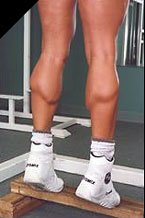 Rolling over on the big toe will stress the lateral head more, while rolling over on the smaller toes will direct more of the resistance to the medial head.
Rolling over on the big toe will stress the lateral head more, while rolling over on the smaller toes will direct more of the resistance to the medial head.
Roll and angle the pressure rather than turning and twisting.
You can increases the intensity of calf training by holding the contraction at the top position for a count of two, lower to the intermediate position for a count of two and lower until your calf muscle is fully stretched, and repeat.
The soleus is largely composed of red (slow-twitch or endurance) fibers, but you can develop some of the white fibers by training the soleus in a very fast, yet controlled manner.
 Get To The Bottom Of Things
Get To The Bottom Of Things
-
Train flat footed. Forget the stylish athletic shoes that give you an artificial arch. Train calves in your bare feet or wear combat boots or some other shoe that is flat in structure. If you want to build bigger calves, you are going to have to get to the bottom of things.
Lock the knees with standing and donkey raises to keep the tension on the gastrocnemius. Don't allow the tension to shift to other areas by putting a bend in your knees.
Since the calves are a very different type of muscle, they can be trained more than other muscle groups. You can train the calves every other day, unless you are sore from the previous calf training workout. You can also split up your gastrocnemius and soleus training so you are training them separately.

Training Programs

 Calf Training Program #1
Calf Training Program #1
Monday:
Standing Raises - heavy poundage - 3 sets of 4 repetitions
Seated Raises - light poundage - 6 sets of 20 repetitions
Toe Raises - light poundage - 4 sets of 10 repetitions
Wednesday:
Donkey Raise - heavy poundage - 3 sets of 4 repetitions
Seated Raises - light poundage - 6 sets of 20 repetitions
Toe Raises - moderate poundage - 3 sets of 8 repetitions
Rebound Training - 3 sets of 10 repetitions
Friday:
Leg Press Calf Raises - heavy poundage - 3 sets of 4 repetitions
Seated Raises - light poundage - 6 sets of 20 repetitions
Toe Raises - light poundage - 4 sets of 10 repetitions
 Calf Training Program #2
Calf Training Program #2
-
Monday:
Standing Raises - heavy poundage - 3 sets of 4 repetitions
Rebound Training - 3 sets of 10 repetitions
Wednesday:
Seated Raises - light poundage - 6 sets of 20 repetitions
Toe Raises - moderate poundage - 3 sets of 8 repetitions
Friday:
Donkey Raises - heavy poundage - 3 sets of 4 repetitions
Rebound Training - 3 sets of 10 repetitions
The following Monday begin with soleus training rather than gastrocnemius training.

Conclusion 
Now that you have more facts on the structure of the calf muscle, you have the power to train them to their full potential. Use this information and take your lower leg development to the next level and blow away the competition.
 For more information
click here to visit my main page.
For more information
click here to visit my main page.
About The Author
Karen Sessions has been in the fitness industry since 1988. She embarked on weight training to overcome an eating disorder, Anorexia Nervosa in its early stages. She overcame the eating disorder, received her personal training certificate, competed in many local bodybuilding contests, and qualified for Nationals. Since then she's went on to write five e-books (Weight Loss, Female Bodybuilding, Contest Preparation, Leg Training, and Figure/Fitness Secrets). Karen's sole goal is to educate others and help them apply that knowledge.
© Copyright 2004 Karen Sessions All Rights Reserved
